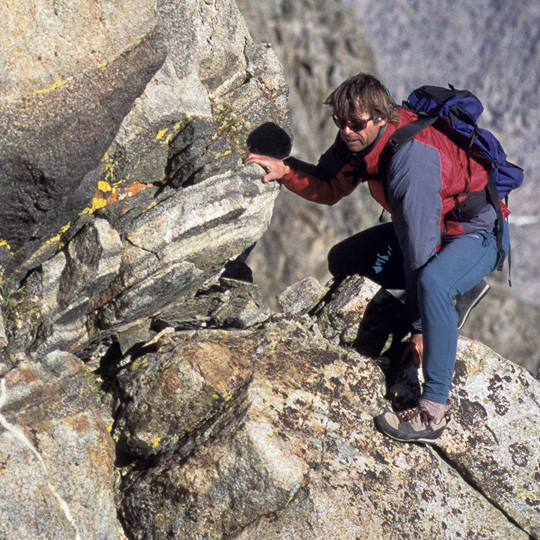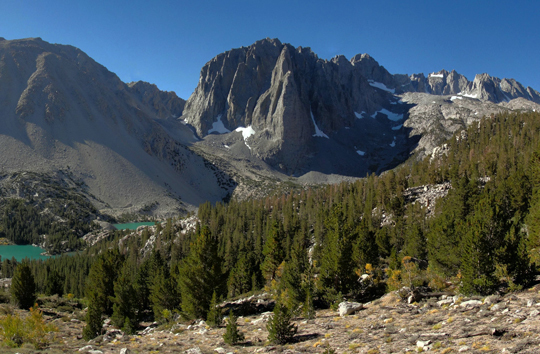
I was 500 feet from the top of Dark Star when the rain settled in for good. A dizzying vortex of mists sucked through a small notch below, cutting me off from the dark walls and the gloomy gulf. The overhanging crack I was climbing was mostly dry so far, but I knew water rivulets were already guttering down from the arete toward my hand and finger jams. Thunder shook the bedrock itself, and my rucksack–overloaded with a gallon of water and a loafs’ worth of peanut-butter sandwiches–tugged me over backwards every time I looked up. I was miserable, my chalk bag a sad sack of white paste.
Just shy of completing the longest technical climb in the High Sierra, I should have been pleased, or jacked up–or something. After all, barring earthquakes or lightning bolts, I’d likely beat the worst of the storm to the summit. But instead I was just dully depressed. I’d wanted to go a whole lot farther.
The Sierra Nevada contain the most ideal traversing terrain in the Lower 48, and there’s good reasons for this: one part California weather, one part accessibility and about five parts simply the way these mountains have grown up. More than anywhere else, this range seems to want to form into long, sharp ridges. Clearly there are technical theories to explain how this genesis occurred, but to the light-footed and itchy-fingered alpinist, these unromantic explanations smack of mere mumbo jumbo, distractions from the alpenglow-ed sawblades of granite that ride high above the pocket glaciers. For the up-and-at-’em climber, such nerdy lingo deserves to stay well hidden in the world of books.
The Palisades, especially, could be considered the local epicenter of sideways mountaineering. It’s been going on here for a good eighty years (since Jules Eichorn and Glen Dawson traversed the razor-fanged ridge from Norman Clyde Peak to Middle Pal). More than merely a way to bag additional summits, it is the notion that one route/one mountain was not enough, that the high places are something to hunger for, to grab onto and to stay in as long as possible like a child refusing to come down from a tree. It was this line-in-the-sky romantic ideal that I was trying to follow when the rain set in.
My plan had been to leave my house in Bishop predawn, hoof it up to Temple Crag, climb the longest route there–and then make it longer. Heading southwest, I’d follow the ragged ridge over Mt. Gayley to the buff white granite on the Swiss Arete of Sill, where I’d hit the main crest and swing northwest over a high handful of peaks, including the Palisades’ highest, North Pal, before finishing with the northernmost: Mt. Agassiz. In the course of the day, I’d traverse tottery gendarmes as well as fine-textured bedrock; frost-fractured, lightning-blasted mountaintops along with flint-hard summits bald as a bottle. Along the way, sure, I hoped I’d taste the ecstasy of an eagle in flight. I also knew that I’d experience the despair of a galley slave. But I’d failed almost as soon as I started, and I slunk home soaked to the skin with most of my water and all of my sandwiches.
This dressing down left a mark, deep enough to make me wait a year before trying something like that again. This time I reasoned I needed to start earlier and climb faster in case of storms, so I decided to begin with the shorter and easier Moon Goddess Arete. It seemed like a smarter choice and a sound plan, but I once saw a quote that read, “Courage, not compromise, brings the smile of God’s approval.” So what was I? Cowardly or clever? Hard to say, but when I ventured into the realm of thunderheads and lightning bolts, I sure didn’t want Him mad at me.
Hours before daylight, I strapped on my headlamp and lit out with fresh batteries and sandwiches. Sunup found me halfway up Moon Goddess, and the orange glow took the gloom out of the dark grey granite. The first peak, Temple, with its church-y name, seemed the perfect place for breakfast. I paused there and read my rain-smeared summit entry from the year before.

The knife-edges and summits rolled by–Gayley, Sill, Polemonium, the high witches’ hat of North Pal, and by early afternoon, the bare-knuckled thumb of Thunderbolt. So far, no thunderheads in the vicinity, but (as I’d feared) the first storm clouds of altitude sickness were squeezing my head. Anything more than a brief sip brought me to verge of vomiting. My pace and condition spiraled downward until I was circling the drain. Winchell seemed never-ending and Agassiz, the last, actually was–a death march of numbness and throbbing all at the same time. I was reduced to walking on all fours like a bear, stopping now and then to see if I had the strength to puke. I tried to dredge up memories of why I was there, but the clouds in my head were far too heavy and choked, and I just had to trust that there was a reason.
The descent took more ages. Finally, as I neared Third Lake at around 10,000 feet, the vise grips on my temples eased up, and I was able to take a few swigs of water. As I hiked down into the thicker air, the world I knew should have slowly morphed back to normal. Instead, it swiftly turned weird.
Late-afternoon sun slanted across a flowered meadow as I turned a corner on the trail and stood face to face with a woman. She was fairy-tale beautiful with flowing strawberry-blond hair, wearing an ankle-length gauzy silk dress. She looked up, surprised, but then smiled shyly. I knew I likely appeared half leprous–all sunburned and scraggly haired–and instinctively I dropped my head in shame. Wretchedness such as mine shouldn’t look pure beauty in the eyes. But I had to try…. She’d vanished! I was standing in a large clearing, and I’d only looked away for a second. There was nowhere for her to hide. Everything else looked quite normal–the pine trees, the rocks, the sky. In the midst of my everyday world, a red-haired angel had come and gone in a flash.
The vision staggered me, but I continued on my way down. The image of her face stayed with me even as my hunger finally returned and visions of French fries accompanied her in my mind’s eye. Soon the smell of fresh sliced potatoes in hot oil drowned out all other thoughts. I stopped and scoured the countryside for the deep fryers that just had to be there–only I knew I was still five miles from the nearest road.
Since our oldest ancestors stood up on their hind legs and gained the first semblance of having a clue, we’ve lifted our eyes to the mountains and seen them as an ultimate, as a place to commune or worship. For some people, the highest summits are singularly important because they are just that much closer to heaven. To me, those are heady thoughts, but I’d like to think that the striving, the beauty and the rapture we experience bring heaven that much closer to home–and that Heaven can be whatever you dream of–like a beautiful girl and a bag of chips.

This week, we’re publishing the four essays from the Palisades Mountain Profile, including Joan Jensen’s thoughts on “The Nature of Memory” and Cam Burns’s retelling of his “backside” adventures with Steve Porcella. Daniel Arnold tracks the histories of the Palisades’ early pioneers while Peter Croft does what Peter Croft does best. We’re also publishing a bonus essay by Steve Porcella about his quest for the “remote, barren, trailless, treeless, oxygenless and peopleless,” where he finds out what it is to really know a mountain range. CLICK HERE to read the essays as they progressively become available, or purchase a copy of the entire issue in our online store.–Ed.